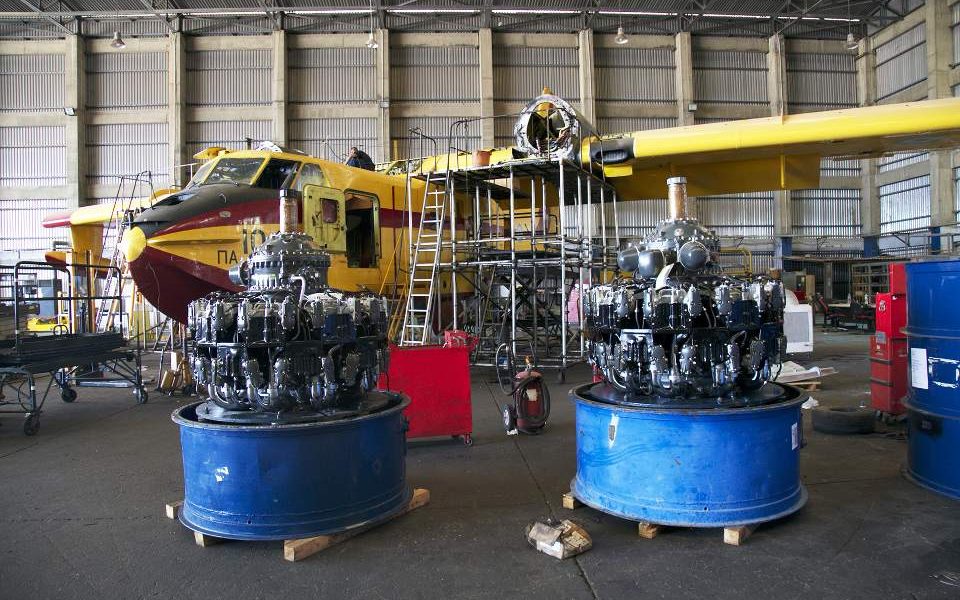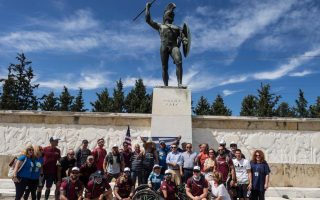Sons succeed fathers in the cockpits of country’s Canadairs

YIANNIS PAPADOPOULOS
There is no time to lose in the main hangar of the Aircraft Maintenance Squadron at the airbase in Elefsina, west of Athens. Poised atop ladders or hunkered down in the fuselage of a Canadair CL-215, aircraft engineers with grease-stained hands are busy carrying out repair work. Their unit is on call from the crack of dawn to sunset every day, as water-dropping aircraft such as this one – with 40 years in the skies weighing on their weary wings – are mobilized every summer to do battle with forest fires around the country.
The mission of the officers who fly them and the crews that maintain them is daunting, as mechanical trouble is a regular occurrence. In two cases at least, Kathimerini learns, sons have succeeded their fathers in the cockpits of Greece's firefighting Canadairs. One of them lost his father when his plane went down 17 years ago, and another was just recently assigned to fly a Canadair after piloting a Mirage 2000 fighter jet.
“Of course we're worried; worry is always there when you're flying,” says Wing Commander Odysseas Chiotis when we meet him at the base of the 355 Regular Transport Squad in Elefsina. “These planes are much more vulnerable to breakdown than the newer aircraft,” he adds.

Wing Commander Odysseas Chiotis (left) and flight lieutenants Maximos Giamouridis and Michalis Chrysanthopoulos fly planes that are over 40 years old.
Three of the red and yellow water-dumping planes are parked on the tarmac. These three were augmented by a fourth when they were fighting a large blaze in Kalamos, north of Athens, earlier this month. But on August 15 it experienced engine problems and had to land at the base in Tanagra, near the location of the fire. Aircraft engineers from Elefsina had to take their gear and parts up to the northern Athens base to get it back in working order.
Greece has a fleet of 11 Canadair CL-215s, nine of which were given to the fire service this summer by the Hellenic Air Force. The majority were purchased between 1974 and 1979.
Challenges
The captains of these planes tell Kathimerini that the aircraft's advanced age just makes their job that much harder. In contrast to the newer Canadair CL-415 (four of which have been given to the fire service this year), the older models cannot refuel at any civilian airport. If they have to rely on a regular airport, then fuel needs to be transported there, significantly raising the cost of the firefighting operation and hampering the planes' participation in other efforts. As one captain explains, if one of the older Canadairs takes off from Elefsina to fight a fire on the southeast Aegean island of Rhodes, it will only be able to dump water for half to three-quarters of an hour before it has to return for refueling.
Meanwhile, these planes are not allowed to take off in temperatures of 38 Celsius or higher due to the risk of conflagration, so they have to be transferred to other bases where conditions are cooler when there's a heat wave in the capital. There are a lot of engine and safety checks before any of the aircraft is allowed to take off, which often reveal problems and lead to delays or even the cancellation of the planned flight.
Another problem is that the older Canadairs' seats are not equipped with dampers, so the pilots feel every bump and jolt – and there are many of these, especially when the fuselage hits the surface of the sea at a speed of more than 60 miles an hour to take in water. “When it is loaded with water, the craft behaves much differently, like a truck with a full load trying to navigate a narrow ravine,” says Flight Lieutenant Maximos Giamouridis, who took part in the firefighting effort on Kythera a couple of weeks ago.

Fighting the flames
Canadairs have two tanks with a total capacity of 6 tons of water that is mixed inside the aircraft with fire-retardant foam. Their captains stress that the planes cannot put out a fire alone. The bulk of the work in battling forest and bush fires is carried out by the ground crews, with the planes acting as a backup. “The trick is to hit the fire right when it starts, before it gets out of control because of the weather,” says Flight Lieutenant Michalis Chrysanthopoulos.
As is the case for firefighters on the ground, those up in the air have to secure escape routes at every step of the way. “You need to look out for obstacles like high-voltage electrical wires or downward airflows. You need to make sure that there isn't a rock face looming behind the flames,” says Chiotis.
“We are battling the elements of nature,” adds Dimitris Chrysikos, the 355 Squad's operations officer.
Maintenance
At the Elefsina base, two Canadair CL-215s are undergoing regular maintenance inspections. The aircraft need to be taken apart (the engines, landing gear and water-dumping systems are all removed), inspected and reassembled either once a year or after every 300 flying hours. The aircraft engineers and fliers explain that the fleet's 11 old Canadairs cannot all be put into service in the summer period as some are used for training during the winter and need to undergo service and maintenance during the fire season.

Crews of the Aircraft Maintenance Squadron work tirelessly to keep the Canadair fleet airworthy during fire season.
“It's like sitting around all winter and suddenly having to run a marathon in the middle of the summer. It takes some practice at first,” says Chiotis. “The same goes for the planes. If you suddenly dump a whole bunch of flying hours on them, they will inevitably present problems.”
“Their advanced age affects their ability to participate in operations and their capabilities, but not flight safety,” assures Nikos Faklaris, a wing commander and the chief engineer at the Elefsina facility.
The work done by the squad's 90 engineers and mechanics is crucial for these planes to keep aiding firefighting efforts in the summer, when the strength of the Elefsina team is augmented with 20 colleagues from the Hellenic Aerospace Industry. The winter months are not much easier, as this is when the entire fleet undergoes its annual overhaul. “We are also running a long-distance race here,” says Faklaris.





